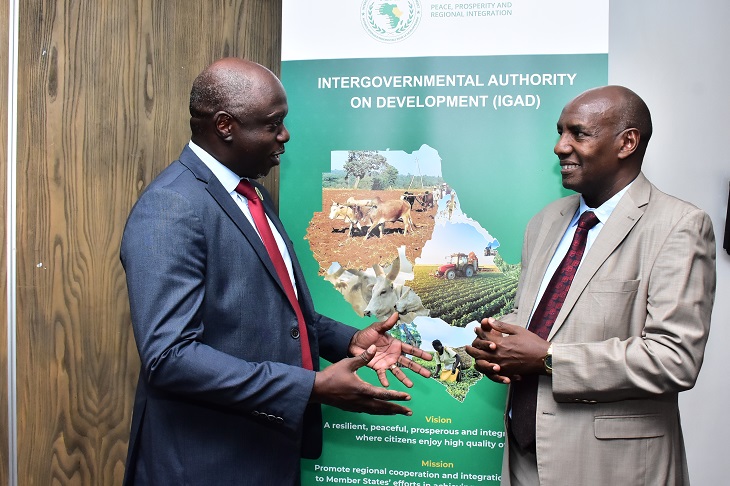42 million people face high levels of acute food insecurity this year across six IGAD member states (Djibouti, Kenya, Somalia, South Sudan, the Sudan, and Uganda), according to the IGAD Regional Focus of the 2025 Global Report on Food Crises released today.
In five countries with comparable data since 2016 (Kenya, Somalia, South Sudan, the Sudan, and Uganda), the number of people facing high levels of acute food insecurity has tripled over recent years – from 13.9 million in 2016 during the first edition of the Global Report on Food Crises to 41.7 million in 2025.
The Sudan and South Sudan are the largest and most severe food crises in the region. The Sudan currently has the largest highly food-insecure population in the region, at 24.6 million, with Famine and risk of Famine in multiple areas. Meanwhile, South Sudan continues to have the largest share of people (57 per cent) in IPC Phase 3 and above in the region, with two of its counties at risk of Famine.
From conflict to economic challenges and climate extremes, the drivers of acute food insecurity in the IGAD region are interlinked and mutually reinforcing, increasing vulnerabilities, undermining resilience, and reversing development gains. The situation is expected to deteriorate further, as the latest forecast by IGAD’s Climate Prediction and Applications Centre (ICPAC) points to drier-than-usual conditions in parts of the region, including southern Ethiopia, eastern Kenya and much of Somalia. Some of these areas, particularly central and northern Somalia, have already experienced at least one below-average rainy season, and drought conditions already persist. Another below-average season risks driving further deteriorations in food insecurity and malnutrition.
Acute malnutrition remains at alarming levels across the region, with 11.4 million children aged 6–59 months acutely malnourished in seven member states. Among them, 3.1 million urgently need lifesaving treatment for severe acute malnutrition. However, due to significant funding cuts, an estimated 1 million people could be left without access to this treatment.
Furthermore, the IGAD region continues to have more forcibly displaced people in the world. As of the end of June, 23.2 million people were living in forced displacement, including 17.8 million internally displaced (IDPs) and 5.4 million refugees and asylum seekers. The Sudan remains the world’s largest internal displacement crisis with about 10 million IDPs. Meanwhile, Uganda continues to host the largest refugee population on the continent, with over 1.9 million. Displaced populations face some of the worst food security and nutritional outcomes due to a loss of livelihoods and social support networks, and a heavy reliance on humanitarian assistance at a time of reduced funding.
IGAD’s Executive Secretary, H.E. Dr. Workneh Gebeyehu, stated: ” The food crisis in our region is more than just hunger; it’s a stark reminder of the interconnected challenges we face, conflict, the severe effects of climate change, economic shocks, and displacement. As IGAD, we strive to bring countries together, strengthen cooperation, and promote resilience, peace, and security. No single institution can tackle these crises on its own. Through collective action, working across governments, regional institutions, and partners, we can address the root causes of vulnerability and create lasting solutions for our people.”
FAO Subregional Coordinator for Eastern Africa ad-interim, Farayi Zimudzi, noted, “As this report shows, the IGAD region continues to face severe food insecurity, and the situation is worsening. Rural agricultural communities are among the worst affected. With another poor rainy season expected in some parts of the region, we must act now to protect rural livelihoods with anticipatory actions. However, anticipatory action alone won’t break the cycle. They must be paired with long-term resilience building and investment in sustainable agriculture to ensure no one is left behind.”
WFP’s Regional Director for Eastern and Southern Africa, Eric Perdison, said, “The scale of the hunger crisis across the region is deeply alarming, with more people affected than the entire population of many countries elsewhere. In Sudan, famine is already unfolding, and the situation could worsen. While working together to save lives is an immediate priority, we must also build resilience and support communities in standing on their own feet and not being forced to depend on humanitarian assistance for survival.”
The seventh edition of the IGAD Regional Focus of the Global Report on Food Crises continues to provide essential information, analyses, and insights to collectively address the causes and consequences of escalating acute food insecurity and malnutrition in the region.
It is a by-product of the annual Global Report on Food Crises (GRFC 2025), which is the result of a complex, multi-partner, consensus-based process involving commitment and contributions from a multitude of agencies and individuals. It is facilitated by the Food Security Information Network (FSIN) in the framework of the Global Network Against Food Crises (GNAFC).
Related Content: IGAD And EU Joins Kenya In The Fight Against COVID-19













